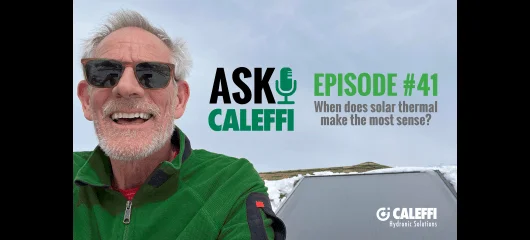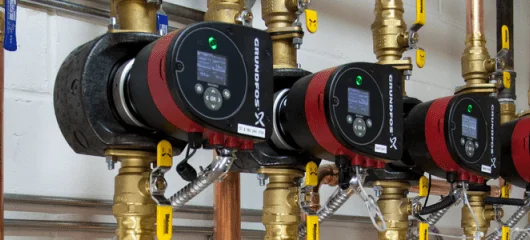Hydronic systems strive for and will reach a condition called thermal equilibrium. Simply put, this condition exists when the rate of heat from emitters matches the rate of heat being added to the system. Example of "emitters" could be a radiant floor or panel, fin tube baseboard, air coils or really any type of heat dissipator. Heat energy can be added to the emitter by a boiler, heat pump, solar thermal, even a tank above a wood fire, a.k.a. an outdoor wood furnace.
Be aware that the condition where the two components - the heat input device and the heat emitter - reach the state of thermal equilibrium may not be what you want or had in mind. A system reaches thermal equilibrium when temperature in all parts have stabilized.
Thermal equilibrium can be measured with temperature sensors on the piping, both suppy and return. This can be measured with temperature sensors on the piping, supply and return to the boiler, for example. It may take time for a large, high mass system (e.g., a radiant concrete slab) to reach equilibrium. The slab can absorb heat much faster than the boiler can produce it, especially at design load or on extreme cold conditions. A technician or system troubleshooter needs to understand this “transient” stage as the system fires up and wait for stable temperatures before beginning any troubleshooting steps.

An ideal system would have the boiler's actual thermal output match the heat emitters. An example in idronics 32 page 7 illustrates a 20,000 boiler connected to 31 feet of common residential fintube baseboard capable of emitting 20,000 BTU/hr. When thermal equilibrium is met, the boiler supply stabilizes at 180°F.
If the fin tube length was increased to 111 feet and connected to the same 20,000 BTU/hr heat source, the equilibrium would be 120°F at the boiler supply. With a conventional, cast iron non-condensing boiler that would be an unfavorable operating condition.
There are no boiler adjustments you can make to correct this thermal imbalance. The boiler simply doesn’t have the output to accomodate the load at a safe operating temperature.
The opposite condition would be an oversized boiler as compared to the heat emitter. Double the boiler output in our example to 40,000 BTU/hr connected to 31’ of fin tube. Thermal equilibrium would be reached with the boiler supply around 250°F! Luckily, the boiler has an operating control and high limit temperature control to prevent the boiler from operating at the elevated temperature.
More commonly the boiler or heat source will be smaller or larger than required. A perfectly matched system is possible with careful design and product selection.
So, to make a long story long… heat emitters will always drive the operating condition of the heat source. It is the control intervention that prevents the heat sources from operating at undesirable temperature conditions. Limit controls or return temperature protection devices are requried!
Refer to idronics 23 for more information on the topic of thermal equilibrium.
-Bob "Hot Rod" Rohr, Training and Education Manager





